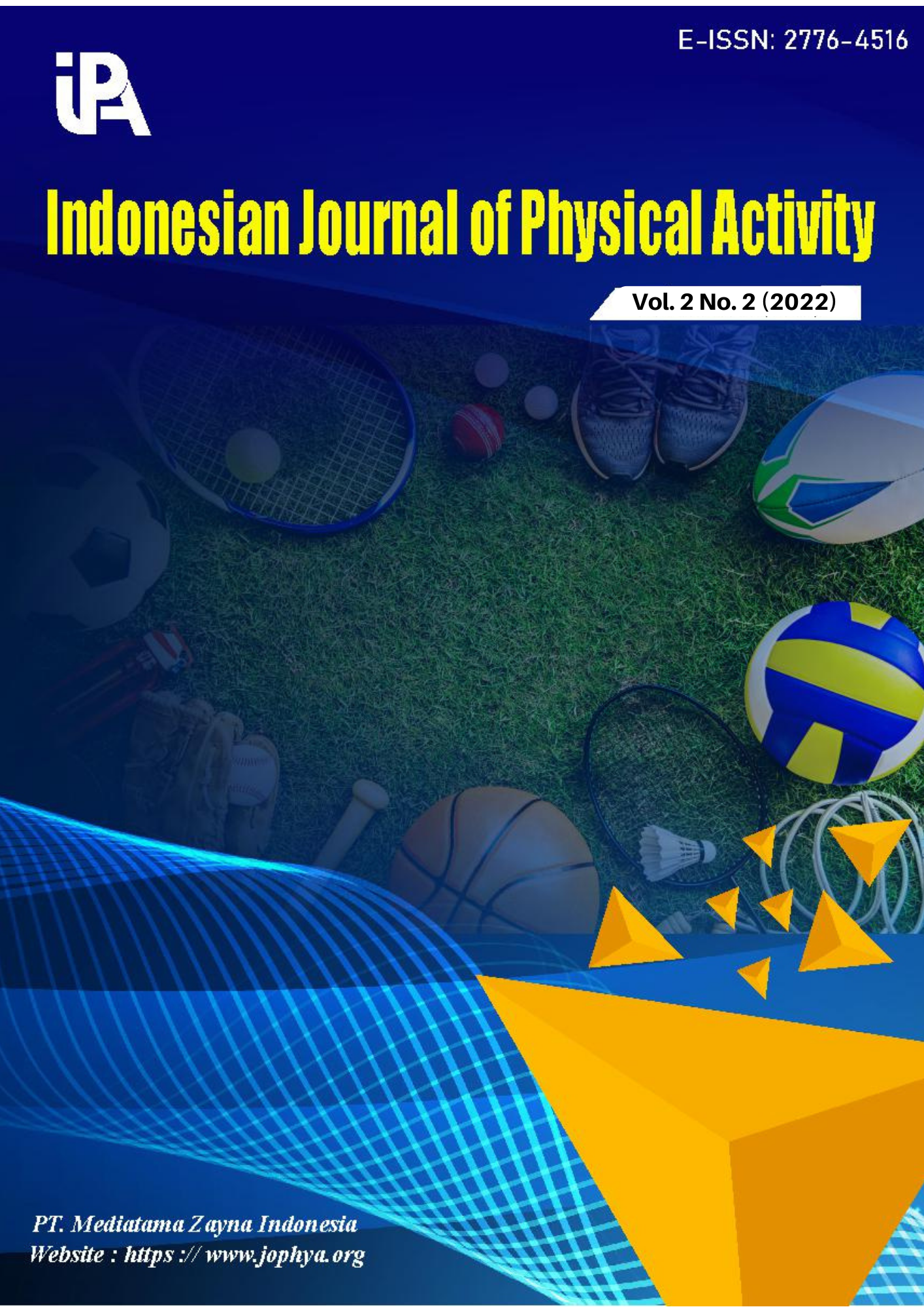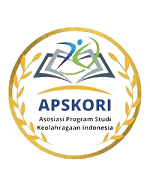Dampak Literasi Fisik Terhadap Kesehatan dan Aktivitas Fisik Remaja: Tinjauan Sistematis Bukti Empiris
Abstract
Penelitian ini bertujuan untuk meninjau bukti empiris mengenai hubungan antara literasi fisik dengan kesehatan dan aktivitas fisik remaja. Melalui tinjauan sistematis, studi ini menganalisis 45 artikel penelitian yang diterbitkan dalam kurun waktu 2010-2021. Hasil menunjukkan bahwa literasi fisik memiliki korelasi positif dengan tingkat aktivitas fisik, kesehatan mental, dan kesejahteraan umum remaja. Intervensi berbasis literasi fisik yang terintegrasi dalam kurikulum sekolah menunjukkan efektivitas yang signifikan dalam meningkatkan motivasi bergerak, kepercayaan diri, dan kebiasaan aktivitas fisik jangka panjang. Namun, terdapat variasi dalam metodologi pengukuran dan implementasi program yang perlu distandarisasi. Penelitian ini memberikan landasan bukti untuk pengembangan kebijakan dan program yang mempromosikan literasi fisik sebagai strategi fundamental dalam mengatasi masalah sedentari dan meningkatkan kesehatan remaja.
Downloads
References
Barnett, L. M., Lai, S. K., Veldman, S. L. C., Hardy, L. L., Cliff, D. P., Morgan, P. J., Zask, A., Lubans, D. R., Shultz, S. P., & Ridgers, N. D. (2016). Correlates of gross motor competence in children and adolescents: a systematic review and meta-analysis. Sports Medicine, 46, 1663–1688.
Barnett, L. M., Van Beurden, E., Morgan, P. J., Brooks, L. O., & Beard, J. R. (2009). Childhood motor skill proficiency as a predictor of adolescent physical activity. Journal of Adolescent Health, 44(3), 252–259.
Belanger, K., Barnes, J. D., Longmuir, P. E., Anderson, K. D., Bruner, B., Copeland, J. L., Gregg, M. J., Hall, N., Kolen, A. M., & Lane, K. N. (2018). The relationship between physical literacy scores and adherence to Canadian physical activity and sedentary behaviour guidelines. BMC Public Health, 18, 1–9.
Brian, A., Pennell, A., Taunton, S., Starrett, A., Howard-Shaughnessy, C., Goodway, J. D., Wadsworth, D., Rudisill, M., & Stodden, D. (2019). Motor competence levels and developmental delay in early childhood: A multicenter cross-sectional study conducted in the USA. Sports Medicine, 49, 1609–1618.
Bronfenbrenner, U. (2005). Making human beings human: Bioecological perspectives on human development. sage.
Cairney, J., Dudley, D., Kwan, M., Bulten, R., & Kriellaars, D. (2019). Physical literacy, physical activity and health: Toward an evidence-informed conceptual model. Sports Medicine, 49, 371–383.
Corbin, C. B. (2016). Implications of physical literacy for research and practice: A commentary. Research Quarterly for Exercise and Sport, 87(1), 14–27.
Dudley, D., Cairney, J., Wainwright, N., Kriellaars, D., & Mitchell, D. (2017). Critical considerations for physical literacy policy in public health, recreation, sport, and education agencies. Quest, 69(4), 436–452.
Edwards, L. C., Bryant, A. S., Keegan, R. J., Morgan, K., Cooper, S.-M., & Jones, A. M. (2018). ‘Measuring’physical literacy and related constructs: a systematic review of empirical findings. Sports Medicine, 48, 659–682.
Edwards, L. C., Bryant, A. S., Keegan, R. J., Morgan, K., & Jones, A. M. (2017). Definitions, foundations and associations of physical literacy: a systematic review. Sports Medicine, 47, 113–126.
Egger, M., Smith, G. D., Schneider, M., & Minder, C. (1997). Bias in meta-analysis detected by a simple, graphical test. Bmj, 315(7109), 629–634.
Faigenbaum, A. D., MacDonald, J. P., & Haff, G. G. (2019). Are young athletes strong enough for sport? DREAM On. Current Sports Medicine Reports, 18(1), 6–8.
Francis, C. E., Longmuir, P. E., Boyer, C., Andersen, L. B., Barnes, J. D., Boiarskaia, E., Cairney, J., Faigenbaum, A. D., Faulkner, G., & Hands, B. P. (2016). The Canadian assessment of physical literacy: development of a model of children’s capacity for a healthy, active lifestyle through a Delphi process. Journal of Physical Activity and Health, 13(2), 214–222.
Gunnell, K. E., Longmuir, P. E., Barnes, J. D., Belanger, K., & Tremblay, M. S. (2018). Refining the Canadian Assessment of Physical Literacy based on theory and factor analyses. BMC Public Health, 18, 1–15.
Hardman, K., Murphy, C., Routen, A., & Tones, S. (2013). World-wide survey of school physical education.
Holfelder, B., & Schott, N. (2014). Relationship of fundamental movement skills and physical activity in children and adolescents: A systematic review. Psychology of Sport and Exercise, 15(4), 382–391.
Hulteen, R. M., Morgan, P. J., Barnett, L. M., Stodden, D. F., & Lubans, D. R. (2018). Development of foundational movement skills: A conceptual model for physical activity across the lifespan. Sports Medicine, 48, 1533–1540.
Katzmarzyk, P. T., Janssen, I., & Ardern, C. I. (2003). Physical inactivity, excess adiposity and premature mortality. Obesity Reviews, 4(4), 257–290.
Keegan, R. J., Barnett, L. M., Dudley, D. A., Telford, R. D., Lubans, D. R., Bryant, A. S., Roberts, W. M., Morgan, P. J., Schranz, N. K., & Weissensteiner, J. R. (2019). Defining physical literacy for application in Australia: a modified Delphi method. Journal of Teaching in Physical Education, 38(2), 105–118.
Kohl, H. W., Craig, C. L., Lambert, E. V., Inoue, S., Alkandari, J. R., Leetongin, G., & Kahlmeier, S. (2012). The pandemic of physical inactivity: global action for public health. The Lancet, 380(9838), 294–305.
Kriemler, S., Meyer, U., Martin, E., van Sluijs, E. M. F., Andersen, L. B., & Martin, B. W. (2011). Effect of school-based interventions on physical activity and fitness in children and adolescents: a review of reviews and systematic update. British Journal of Sports Medicine, 45(11), 923–930.
Lander, N., Eather, N., Morgan, P. J., Salmon, J., & Barnett, L. M. (2017). Characteristics of teacher training in school-based physical education interventions to improve fundamental movement skills and/or physical activity: A systematic review. Sports Medicine, 47, 135–161.
Lee, I.-M., Shiroma, E. J., Lobelo, F., Puska, P., Blair, S. N., & Katzmarzyk, P. T. (2012). Effect of physical inactivity on major non-communicable diseases worldwide: an analysis of burden of disease and life expectancy. The Lancet, 380(9838), 219–229.
Lloyd, R. S., Oliver, J. L., Faigenbaum, A. D., Howard, R., Croix, M. B. A. D. S., Williams, C. A., Best, T. M., Alvar, B. A., Micheli, L. J., & Thomas, D. P. (2015). Long-term athletic development-part 1: a pathway for all youth. The Journal of Strength & Conditioning Research, 29(5), 1439–1450.
Longmuir, P. E., & Tremblay, M. S. (2016). Top 10 research questions related to physical literacy. Research Quarterly for Exercise and Sport, 87(1), 28–35.
Lubans, D. R., Morgan, P. J., Cliff, D. P., Barnett, L. M., & Okely, A. D. (2010). Fundamental movement skills in children and adolescents: review of associated health benefits. Sports Medicine, 40, 1019–1035.
Martins, J., Onofre, M., Mota, J., Murphy, C., Repond, R.-M., Vost, H., Cremosini, B., Svrdlim, A., Markovic, M., & Dudley, D. (2021). International approaches to the definition, philosophical tenets, and core elements of physical literacy: A scoping review. Prospects, 50(1), 13–30.
Pabayo, R., Spence, J. C., Cutumisu, N., Casey, L., & Storey, K. (2012). Sociodemographic, behavioural and environmental correlates of sweetened beverage consumption among pre-school children. Public Health Nutrition, 15(8), 1338–1346.
Prince, S. A., Adamo, K. B., Hamel, M. E., Hardt, J., Gorber, S. C., & Tremblay, M. (2008). A comparison of direct versus self-report measures for assessing physical activity in adults: a systematic review. International Journal of Behavioral Nutrition and Physical Activity, 5, 1–24.
Robinson, D. B., Randall, L., & Barrett, J. (2018). Physical literacy (mis) understandings: What do leading physical education teachers know about physical literacy? Journal of Teaching in Physical Education, 37(3), 288–298.
Sallis, J. F., Owen, N., & Fisher, E. (2015). Ecological models of health behavior. Health Behavior: Theory, Research, and Practice, 5(43–64).
Sallis, J. F., & Saelens, B. E. (2000). Assessment of physical activity by self-report: status, limitations, and future directions. Research Quarterly for Exercise and Sport, 71(sup2), 1–14.
Sheehan, D. P., & Katz, L. (2012). The Impact of a Six Week Exergaming Curriculum on Balance with Grade Three School Children using the Wii FIT+TM. International Journal of Computer Science in Sport (International Association of Computer Science in Sport), 11(3).
Spence, J. C., & Lee, R. E. (2003). Toward a comprehensive model of physical activity. Psychology of Sport and Exercise, 4(1), 7–24.
Sterne, J. A. C., Sutton, A. J., Ioannidis, J. P. A., Terrin, N., Jones, D. R., Lau, J., Carpenter, J., Rücker, G., Harbord, R. M., & Schmid, C. H. (2011). Recommendations for examining and interpreting funnel plot asymmetry in meta-analyses of randomised controlled trials. Bmj, 343.
Stodden, D. F., Goodway, J. D., Langendorfer, S. J., Roberton, M. A., Rudisill, M. E., Garcia, C., & Garcia, L. E. (2008). A developmental perspective on the role of motor skill competence in physical activity: An emergent relationship. Quest, 60(2), 290–306.
Tompsett, C., Burkett, B. J., & McKean, M. (2014). Development of physical literacy and movement competency: A literature review. Journal of Fitness Research, 3(2), 53–74.
Tremblay, M. S., Barnes, J. D., González, S. A., Katzmarzyk, P. T., Onywera, V. O., Reilly, J. J., & Tomkinson, G. R. (2016). Global matrix 2.0: report card grades on the physical activity of children and youth comparing 38 countries. Journal of Physical Activity and Health, 13(s2), S343–S366.
Whitehead, M. (2019). Physical literacy across the world. Routledge London, UK:
Copyright (c) 2022 Nur Ihsan HL

This work is licensed under a Creative Commons Attribution-ShareAlike 4.0 International License.
Authors who publish with this journal agree to the following terms:
- Copyright on any article is retained by the author(s).
- The author grants the journal, the right of first publication with the work simultaneously licensed under a Creative Commons Attribution License that allows others to share the work with an acknowledgment of the work’s authorship and initial publication in this journal.
- Authors are able to enter into separate, additional contractual arrangements for the non-exclusive distribution of the journal’s published version of the work (e.g., post it to an institutional repository or publish it in a book), with an acknowledgment of its initial publication in this journal.
- Authors are permitted and encouraged to post their work online (e.g., in institutional repositories or on their website) prior to and during the submission process, as it can lead to productive exchanges, as well as earlier and greater citation of published work.
- The article and any associated published material is distributed under the Creative Commons Attribution-ShareAlike 4.0 International License








1.png)







